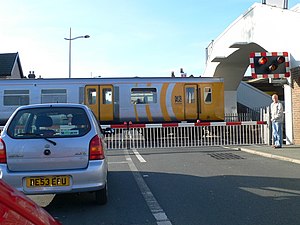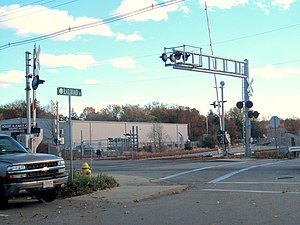Our website is made possible by displaying online advertisements to our visitors.
Please consider supporting us by disabling your ad blocker.
Level crossing

A level crossing is an intersection where a railway line crosses a road, path, or (in rare situations) airport runway, at the same level,[1] as opposed to the railway line crossing over or under using an overpass or tunnel. The term also applies when a light rail line with separate right-of-way or reserved track crosses a road in the same fashion. Other names include railway level crossing,[1] railway crossing (chiefly international), grade crossing or railroad crossing (chiefly American),[2] road through railroad, criss-cross, train crossing, and RXR (abbreviated).
There are more than 100,000 level crossings in Europe and more than 200,000 in North America.
Road-grade crossings are considered incompatible with high-speed rail[3] and are virtually non-existent in European high-speed train operations.[4]
-
A level crossing at Hoylake, Merseyside, England, with a train passing
-
An active level crossing in Japan, 2022, train approaching from left
-
A railroad crossing in Abington, Massachusetts, US
- ^ a b VicRoads (26 August 2014). "Trains & level crossings". VicRoads. Retrieved 12 November 2017.
- ^ "Highway-Rail Grade Crossings Overview". Federal Railroad Administration. Department of Transportation. 4 December 2019. Retrieved 18 June 2020.
- ^ JAMES J. ROZEK; JOHN A. HARRISON (1998). "Grade Crossing Safety and Economic Issues in Planning for High-Speed Rail Systems" (PDF). Transportation Research Record (1177): 47. Retrieved 2 April 2024.
Highway grade crossings are generally incompatible with HSR operation
- ^ "EUROPE'S APPROACH TO RAIL CROSSING SAFETY". ITE Journal. 68 (2). Institute of Transportation Engineers: 18. 1998. ISSN 0162-8178. Retrieved 2 April 2024.
with the exception of a few grade crossings in Italy, all high-speed rail crossings are grade separated
Previous Page Next Page





